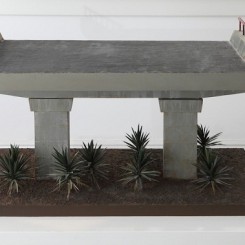“Youth: Everything in Between,” exhibition with Liu Ren & Su Chang.
Don Gallery (Room 26, Blackstone Apartment, No. 1331, Middle Fuxing Road, Shanghai). July 17–29, 2012.
A number of years ago, I walked into a dimly lit show at BizART, and amongst the random assortment of rather confused works, out of the gloom a striking sculptural piece emerged. The work consisted of a partially demolished house, a sort of home “walking-wounded,” an emblem of deep scars left by urban renewal. What was most interesting about this house was the love and care put into every detail of the construction. Certainly more care was put into the production of this artwork than was ever put into building and maintenance of the actual house.
And herein lies the central paradox that makes Su Chang’s work so interesting — the lengths to which the artist goes in order to lovingly re-create the crumbling architecture of the 1990s. He began this series of sculptures in university and his explorations have taken him on a voyage of discovery, moving constantly from one material to another in search of the right combination of pigments to recreate a pattern of variegated mold on a wall or the right materials to represent the texture of crumbling cement. “Like you know how women like to go window shopping for clothes?” he says, “I like to wander around the construction materials market.” There he finds different kinds of textures: tubes, plastics, wire — filling his toolbox with anything that might be of use in creating his miniature environments. “Renovated Building” (2012), for example, shows a typical 90s-era “bathroom-tiled” white building with blue glass windows. The base is made of plastic, the surrounding gate is made of wire, the tiles are carved out of a layer of plaster and the windows are made of white plastic and blue acrylic.
But Su Chang’s focus is not merely formal, rather he uses architecture to weave narratives about social change. During his formative years in the 90s, he was surrounded by architecture that evoked a desperate grasping at the “modern.” “We can find this feeling even in the smallest details,” he says, “For instance, these tiles are very cheap, but they looked very high-tech and this represented society’s desire for progress at that time. But inside the architecture is still the same architecture as before, they have just placed a skin on it on the outside [of the building].”
As always with Su Chang, architecture is used as a metaphor for human identity and interaction. In “A Kind of Lifestyle” (2012), for example, a building acts as a symbol of conformity. “It represents our living conditions. Like these buildings in Brilliant City, dense agglomerations of buildings as well as each window represent a person. I think it’s that people are miniscule. If you live within it, you might think that mankind is very powerful, that we are very individualistic and now people are always seeking individuality; it has become a model that we compulsively strive for. But then you find out that you are actually are very weak.”
He also explores the concept of public and private space in other works such as “Wall” (2012) and “Enclosing Wall” (2012). One depicts a compound wall, the other a wall which makes up part of the architectural vernacular of Songjiang’s canals. His interest in walls lies in the way in which walls impact the way we see our environment. They allow for imagination by blocking the view, but because they cannot block sound they always tantalize us with the prospect of secrets which remain hidden.
Many of his works involve not just architecture but plants as well. For instance the plants that grow beneath the freeway — long-leafed tropical plants made out of copper, painted green or even yellow and brown — convey the idea of decay. Meanwhile the amputated plane trees lining the streets of the former French Concession evoke notions of thwarted individual ambitions and the toll that society takes on personal growth.
He takes these elements in varying combinations to create an image of a world in perpetual flux — one where decrepitude and modernity constantly change places like a couple waltzing across a park square on a stifling summer night.
